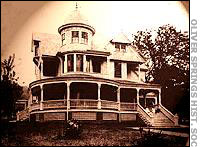|
The two boys edged up to the back door of the old Victorian manse where the spinster sisters lived. Even in broad daylight, there was something unnerving about the place; a kind of faded elegance, a brooding, musty melancholy that seemed to seep up through the planks on the old porch, though those would hardly be the words a pair of third-graders would choose to describe it.
 | | Richards' home |
To the boys the old Richards house had always seemed to ooze a Saturday-morning-movie-matinee spookiness. It was the kind of place where you could imagine Larry Talbot locking himself up on the afternoon before a full moon, before he turned into the Wolfman. It was the kind of place where every creaking stair, every rattling pipe might be a monster.
It wasn't that the sisters, old as they were - they must have been well into their 40s then, their 30s at least - weren't nice enough. Though their family was no longer quite as affluent as it once was -- their fortunes had declined along with the community's when the old mineral springs started to dry up - the Richards sisters still had that streak of southern Christian charity and they practiced it with joy. Everybody in Oliver Springs knew how they had taken that black boy, Powder Brown, under their wings, tossing the 16-year-old orphan as many odd jobs as he could handle to help him out. There was even talk that a few weeks earlier, over Christmas, the Richards sisters had given a suit of clothes to another young black kid who occasionally did some work for them. That was nice. There weren't many black kids in Oliver Springs, Tennessee, who could start off the year 1940 with a new suit of clothes.
Most of the kids in town knew them personally: One of them taught Sunday school at the local church and the youngest, Miss Mary, taught at the elementary school. In fact, it was at her request that the two youngsters had made the trek to the old house. Miss Mary had a note for her sisters, and the boys had been chosen to carry it.
Give their druthers, they might have let somebody else carry the note, but the sisters were so nice, Miss Mary in particular, and besides, there really was no way to say no to a direct request from a teacher. All the same, as they walked alongside the spooky old manse, that faceless dread grabbed hold of them by their collars.
Look there, through the basement window. Is that somebody moving in the shadows? The bare light bulb hanging from the joists, is it swinging back and forth?
The steps creaked as they made their way to the door.
What was that sound, that strange gurgling sound?
It was enough to make the boys forget their chore and flee.
All the horror they could possibly conjure up in their fevered schoolboy imaginations would pale in comparison to the real horror inside the old Richards' house.
On the floor of the kitchen, 48-year-old Ann Richards lay in a sea of blood, a bullet wound in the front of her head. There were signs of a struggle, and in a way, even more chilling evidence of how terribly ordinary the day had been just moments before. The lunch dishes were in the kitchen sink and there was a pot of water warming on the stove.
A few yards away, lying on the landing of the stairway, lay 36-year-old Margaret. She had been shot twice. One bullet struck her in the throat, the kind of wound that makes a person choke and gag on their own blood, gurgling before they die. The other struck her in the head. Upstairs, just a few feet away, was the body of Leonard "Powder" Brown. In his hand, or so it was said, was a .38-caliber pistol, a gun that supposedly belonged to a prominent man in town. In his head, just above his right eye, was the wound that had snuffed out the 16-year-old handyman's life.
 | | Oliver Springs, Tennessee, map |
If it is true today, it was truer still when horror visited the fading southern mountain town of Oliver Springs, Tennessee, in the 1940s. It may seem cliché, but the bloodbath at the old Richards house on the afternoon of February 5, 1940, shook this peaceful community to its soul. There was no easy or satisfactory answer to how or why it happened. And so, the people in Oliver Springs turned to myths. The myths were handy and you could take your pick, choose the bigoted myths of the old segregationist South to explain the mayhem, or choose from the sordid myths of black-hearted oligarchs who, in the tradition of southern Gothic folk tales, would stop at nothing to enrich themselves. The myths could easily be whittled to fit the crime.
It was the rich folks, in league with the lackey local authorities, and it was all about greed, went one version of the story.
No, it was Powder Brown, angry enough to kill because he had been cheated out of a suit of clothes, went another.
It's been more than 60 years since the Richards sisters and Powder Brown died in that old mansion in Oliver Springs. Over the years, the old myths have gotten frayed and no longer serve their purpose. Some have donned other myths to replace them. But, even now, six decades later, the mystery of what happened that day still remains.
|



